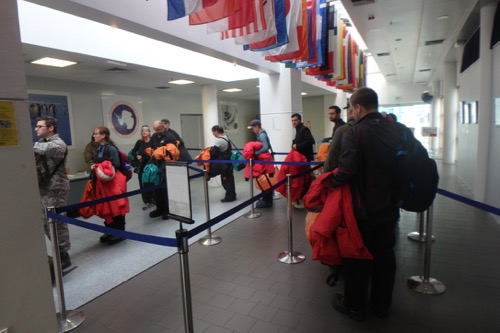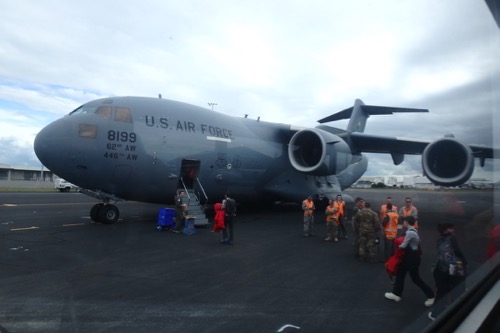Ice Flight
The day started at 4 AM wake-up. Then was a shuttle ride to the USAP at 5:45. We then were weighed and checked in our bags. Then...we were delayed.
 USAP participants in "bag drag" line for boarding flight from Christchurch, New Zealand to McMurdo Station, Antarctica.
USAP participants in "bag drag" line for boarding flight from Christchurch, New Zealand to McMurdo Station, Antarctica.
Delayed
The rumor was that we were going to be delayed because there was some high winds (19 Knots) at McMurdo. That seemed like a plausible reason for a delay. As usual, the rumor was not true. Well, at least partially. We WERE delayed, but not because of high winds. The official word was that the ice runway was too soft. That caused the type of aircraft to be changed, and THAT caused the delay. Originally we were scheduled for a Kiwi (New Zealand) Air Force Boeing 757. We we were then assigned on a U.S. Air Force C-17. The C-17 is much bigger and heavier than the 757, but the wheels distribute the weight of the aircraft over a larger area, and that is better for landing on softer ice and snow.
C-17
 This U.S. Air Force C-17 is loading to take USAP participants to McMurdo Station, Antarctica.
This U.S. Air Force C-17 is loading to take USAP participants to McMurdo Station, Antarctica.
The C-17 is a HUGE U.S. military cargo plane. It is built to carry a lot of very heavy things. There were 36 of us aboard as passengers and we sat in seats that folded down from the outside walls of the plane. In addition to all of us and all of our gear, there was a LOT of cargo. All of the cargo was organized on big pallets that are about 25 feet long and 15 feet across and about 10 feet high. Each of those pallets were strapped and chained down to the floor. There were three of those pallets. On one of the pallets was an entire boat! Directly in front of my jump seat was a huge ski for the front wheels of that airplane that could be fitted to the plane in case it were to be needed while the plane was in Antarctica. The C-17 is not intended for passenger comfort! It was VERY loud and the seats were uncomfortable especially for our 5 hour flight.
 Inside of the cavernous U.s. Air Force C-17. Plenty of room for cargo and passengers, but NOT made for comfort.
Inside of the cavernous U.s. Air Force C-17. Plenty of room for cargo and passengers, but NOT made for comfort.
Cockpit!
We were allowed to go up into the cockpit where the pilots were flying the airplane! Two of us at a time stood next to the Navigator and Flight Engineer where we could see the pilots at the controls of the airplane. It was impressive to see all of the controls, gages, monitors and switches. The pilots answered our questions and explained what some of the various controls did.
 C-17 cockpit on an "Ice Flight" from Christchurch, New Zealand to McMurdo Station, Antarctica.
C-17 cockpit on an "Ice Flight" from Christchurch, New Zealand to McMurdo Station, Antarctica.
Landing
30 minutes before landing we were instructed to put on all of our Extreme Cold Weather gear. Interestingly, it isn't that cold at McMurdo. It is about 20˚F. That is just slightly colder than it is back in Pittsburgh! The reason that we need to wear the ECW gear is two fold. The first reason is purely practical. It is much easier to carry all 22 pounds of Extreme Cold Weather gear than it is to carry it. The second reason is as a safety precaution. In the unlikely event that the plane would crash during the landing process, we would already be wearing all of our gear. That would be much better than either trying to find it in the wreckage or having to do without in the event of a crash.
Once we taxied to a stop, we were instructed to exit the plane. Everyone was excited to get off of the plane and step foot on Antarctica! Many of the people aboard were veterans of "The Ice" and a handful of us were first timers, but everyone was excited! We all stood up, and started shuffling toward the doors. There are no windows inside of the C-17 so was pretty dark as we approached the door. As I got closer to the door, I could feel the cold air blowing into my face. As I stepped into the doorway I could see nothing but a blinding white light...
Stay tuned for my first step onto THE ICE!


Comments
Pagination
Add new comment